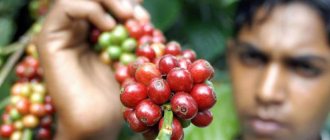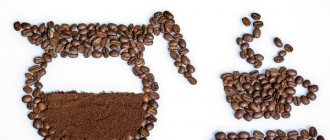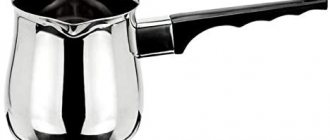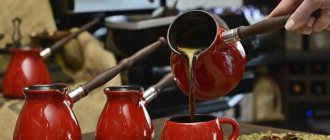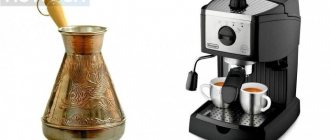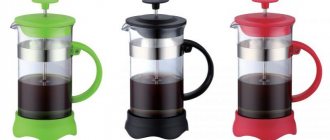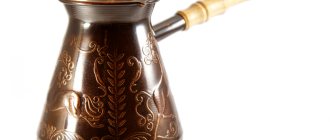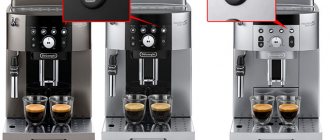Form
Sergey Blinnikov, Russian bronze medalist in preparing coffee in a cezve:
“I hope that somewhere there is a wonderful world in which everyone has the opportunity to buy the perfect cezve: solid, hand-forged, made of pure silver, with thick walls, correct geometry and a bronze handle. In our world, such a thing exists, but it costs $800. So let's look at more realistic options.
The most important thing in a cezve is its geometry, in particular the ratio of the width of the base to the width of the neck. The narrowing should be small but visible, about 20% of the bottom size.
If the neck is too narrow, the coffee tablet that forms during brewing will be too thick and only the coffee that comes into contact with the liquid will be extracted. The top of the tablet may even remain dry.
If the neck is too wide or does not exist at all, then a coffee tablet will not form on the surface. The coffee will boil uncontrollably and overbrew. If you have such a cezve, I advise you to use it for boiling eggs - it’s very convenient.”
What is Turka
Turk is a special vessel for preparing coffee powder with a narrowed, funnel-shaped neck, wide bottom and long handle. It is made of both copper and: ceramics, stainless steel, brass, clay and other materials.
The word “Turk” itself was invented in Russia. The thing is that the name “cezva” did not take root there, so they began to call it Turk, as a sign of the popular preparation of coffee in Turkish (on sand). By and large, turk and cezve are different names for the same utensils for brewing coffee.
Size
Maria Trokhimenko, judge of Russian barista championships and champion of the Far East in cezve coffee:
“Choose a cezve according to the standard size of your cup, for example, 200 or 250 ml. You can also have a very small one, 90 ml, like in Turkish cafes. This volume will cook faster due to less water.
You can, of course, take a 500 ml Turk to prepare several cups at once. But all the brewed coffee needs to be drunk at once. It will not be possible to make a small portion in a large Turk: as in the case of a Turkish Turk that is too wide, the coffee head will not form and the coffee will boil quickly.”
Why did the cezve come to be called the Turk?
In Russia, coffee is traditionally brewed in a Turkish pot, and few people wonder why this is the name of a vessel that is so similar to a Turkish cezve. There are two points of view on the origin of this term.
Most archaeological scientists believe that there is no difference between a Turka and a cezve, and that the term “Turka” simply entered into use among the Russian people as a word that is easier to use than the foreign “cezva.”
Since coffee appeared in Turkey much earlier than in Russia, Turkish merchants had to take the cezve with them on voyages to enjoy their favorite drink away from home. Over time, coffee began to gain popularity in our country, and the utensils for preparing it began to be popularly called “Turks” - after the nationality of the people who so actively use it. But in essence, these two devices are no different from each other.
Experts say that cezves are made from copper, and Turks are made from any other materials
Adherents of the second point of view argue that the Turk is a type of cezve and has a wider and shorter neck. Also, cezves are traditionally made from heavy forged copper, but Turks can now be found - in addition to copper - from steel, aluminum, brass and even ceramics.
Material
Sergei Blinnikov:
“The best choice, besides silver, is copper. It conducts heat well, but does not accumulate it, so it is easy to control the process of making coffee in such a cezve, especially if its walls are thick, about 1.5 mm. It is important that the copper is internally treated with silver or food-grade tin - a material that does not enter into chemical reactions with food. But tin and silver are easily erased, so you need to wash Turks with such a coating very carefully, with your hands and water, without sponges or detergents.
The most famous silver-plated copper Turks are Soy. Participants in cezve championships most often choose them.
If you're neat, consider purchasing a quartz cezve. It shows everything that happens to coffee during the brewing process, it’s fascinating.
Ceramic cezves are quite capricious. They transfer heat unevenly and tend to accumulate it. Coffee can run away when you have already removed the Turk from the heat.”
Maria Trokhimenko:
“Clay absorbs coffee oils, so it can change the taste of coffee. It will not be possible to prepare the same drink in a clay pot two times in a row.
Don't buy an aluminum pot. When heated, aluminum reacts with the drink, changes its taste and is generally considered unsuitable for cookware.
In a stainless steel pot you can achieve relatively good results. But there is a minus - low thermal conductivity. A stainless steel pot heats up unevenly, like a saucepan, and will overheat the coffee in the bottom area. There is a risk that the drink will turn out more bitter.”
How to choose a Turk for brewing coffee
How to choose a Turkish coffee pot among the variety of products so that it is not only comfortable, but also produces only the highest quality coffee? Expert advice will help you make the right purchase.
- The traditional Turk has a cone shape. In it, the grains settle faster, and the foam becomes as clean as possible.
- The thicker the bottom and walls, the better. In such a Turk, uniform heating occurs, and the prepared coffee remains hot longer.
- To get a classic drink, you need to choose containers designed for 1-2 cups.
- For electric stoves, dishes with a smooth and flat bottom are more suitable, for gas stoves - with a rounded bottom.
- The copper Turk is the most practical, and its price is affordable for all buyers.
- Beginners can opt for transparent containers, which will help control the process and avoid coffee boiling over.
- The longer the handle, the more convenient it is. The heat-resistant material will allow you to use the cookware without using oven mitts. Thanks to the removable handle, you can wash the dishes better after cooking.
- In high Turks, the boiling process occurs more slowly, so the drink becomes richer and more aromatic.
- The built-in spout makes it easy to pour coffee into cups. The wider it is, the more convenient it is to do this.
- To achieve an ideal result, the diameter of the neck should be 2-3 times smaller than the diameter of the bottom.
- For a large family or group of friends, Turks with a volume of 500 ml or more are suitable.
To dust or not to dust, that is the question
Sergei Blinnikov:
“Thanks to the grounds, coffee from the cezve continues to be extracted in the cup until it is completely drunk. This is both good and bad: with the right recipe and grinding, the drink will open up better and better every minute!
But there is a problem: with such a long extraction, up to 20-30 minutes, there is a great danger of overbrewing the coffee and getting extra bitterness in the taste. This needs to be taken into account when choosing the grind.
Choose according to the principle “the darker, the larger.” For example, I brewed Yemen Matari No. 4 (light roast), Brazil Irmas Pereira 36 Hour Fermentation No. 170 (medium roast, dark filter), and Honduras San Marcos No. 22 (darker than medium roast). All beans gave off enough sweetness with a coffee to water ratio of 1:8-1:9 (12 g of coffee per 100 ml of water). But Yemen opened up with an espresso grind, and for Honduras we had to take a grind that would be suitable for a Chemex. Unfortunately, with such a coarse grind, the coffee loses its body, but we remove excess bitterness from the drink. Although when brewing group B it is not possible to completely avoid bitterness - this is a dark roast.
If you don’t like grounds in your cup, filter the cezve using paper filters. The V60 funnel or AeroPress will give you a clean drink. But the thicker the layer of paper, the lighter the cup you will get.”
Rating of quality Turks for 2021
Turk Ceraflame Ibriks (500 ml)
| Options | Characteristics |
| Type | Turk |
| Product material | Ceramics, wood, stainless steel |
| Product volume | 0.5 l |
| Thermal insulation handle | Eat |
| Coating material | Enamel |
Country of origin: Brazil. The ceramic product is available in four bright shades and one black color. In addition to its aesthetic purpose, enamel performs a protective function: it protects ceramics from scratches. The shape of the device is cone-shaped, with a straight, elongated spout. The handle is long enough and comfortable to use. If necessary, the handle can be removed from the body. Cooking in a Turk is possible on any stove except induction. Product cost: 3468 rubles.
Turk Ceraflame Ibriks (500 ml)
Advantages:
- High quality;
- Durable;
- Stylish and discreet design;
- The resulting volume of coffee is enough for two cups;
- Thanks to the removable handle, the Turk can be stored compactly.
Flaws:
- High price;
- Heats up slowly;
- The dishes require careful handling.
Turk Tima TU-550s
| Options | Characteristics |
| Device type | Turk |
| Housing material | Copper |
| Handle material | Tree |
| Color | Brown |
| Product volume | 0.55 l |
| Width | 70 mm |
| Height | 130 mm |
Country of origin: Russia. Copper Turk, made in an individual design with a removable wooden handle. This unique vessel is suitable for preparing ground coffee on ceramic, gas and electric stoves. The inner surface of the kitchen device is coated with tin, which eliminates the appearance of copper impurities in the drink. Average price of the device: 841 rubles.
Turk Tima TU-550s
Advantages:
- Affordable price;
- Beautiful design;
- Durable;
- Maintains noble taste;
- The volume is designed for two cups.
Flaws:
- The handle is not smooth enough.
Stainless steel pot "Taller" Jackie 500 ml
| Options | Characteristics |
| Device type | Turk |
| Device volume | 500 ml |
| Device material | Stainless steel |
| Exterior coating and finishing | Mirror polish |
| Material wall thickness | 0.8 mm |
| Handle material | Bakelite |
Brand country: UK. Country of origin: China. An inexpensive vessel from a Chinese manufacturer with European quality. The stainless steel item has a fairly simple structure with a heat-insulating bakelite handle. The advantage of the model is its good price-quality ratio. Stainless steel will last a long time, and the cappuccino in the dish will be tasty and rich. You can buy Jackie for 790 rubles.
Stainless steel pot "Taller" Jackie 500 ml
Advantages:
- Durable due to anti-corrosion properties;
- Easy to clean;
- Sufficient volume for two cups;
- Lightweight and compact;
- Comfortable handle.
Flaws:
- It is necessary to control the coffee brewing process;
- Wide neck;
- According to customer reviews, the fastening of the Turkish handle is not reliable enough.
Turk for induction cookers, 0.75 l, d-9.5 cm, h-11 cm Cilio
| Options | Characteristics |
| Device type | Turk for induction cookers |
| Size | 9.5 cm |
| Volume | 0.75 l |
| Height | 11 cm |
Country of origin: Germany. This German stainless steel cezve is created specifically for espresso lovers. Cookware with a stylish design is suitable for any stove, including induction. The advantage of the model is its double bottom for uniform heating of the liquid. A stylish and high-quality item can be presented as a gift. The product is sold in beautiful packaging. The cost of cookware for induction cookers: 2050 rubles.
Turk for induction cookers, 0.75 l, d-9.5 cm, h-11 cm Cilio
Advantages:
- Decent European quality;
- Suitable for all types of slabs;
- Quite a large volume.
Flaws:
- Not all induction cookers can see this model.
Bronze coffee pot “Estet” 280 ml
| Characteristics | Options |
| Device type | Turk |
| Turks volume | 280 l |
| Weight | 440 g |
| Height | 10 cm |
| Top coating | Bronze, patterned |
| Inner coating | Food tin |
| Handle material | Sandalwood |
Country of origin: India. The product is made in a classic form. The outer covering of the Turk is made of bronze with hand carving. This unique cezve is suitable for beauty connoisseurs and lovers of natural espresso. Heating the vessel is possible on any type of stove except induction. You can buy a bronze model for 2,560 rubles.
Bronze coffee pot “Estet” 280 ml
Advantages:
- Unique design;
- The coffee stays warm for a long time.
Flaws:
- High price;
- The container capacity is for one cup.
Glass Turk Loire 350 ml
| Options | Characteristics |
| Device type | Turk |
| Case material: Turks | Heat resistant glass |
| Handle material | Tree |
| Product volume | 350 ml |
The Turk is made of durable glass that is not afraid of high temperatures. The handle material is wood, so you can carry the vessel to any place without getting burned. Thanks to the wide bottom, the aromatic substance quickly heats up and reaches full readiness. Turka interacts with any stoves except induction type. You can buy a glass Turk for 593 rubles.
Glass Turk Loire 350 ml
Advantages:
- Affordable price;
- You can watch the process of preparing cappuccino;
- Easy to clean;
- Prepares a delicious drink quickly.
Flaws:
- The volume is designed for one person.
Porcelain Turk “Amphora for your own” 450 ml
| Options | Characteristics |
| Device type | Turk |
| Housing material | Heat-resistant porcelain |
| Handle material | Tree |
| Item height | 12 cm |
| Product volume | 450 ml |
| Product weight with packaging | 460 g |
Country of origin: Russia. The porcelain model can be used in conjunction with an electric, gas and ceramic stove. A pot with a fairly wide bottom and a narrow neck so that the liquid quickly warms up and acquires a rich taste. You can buy something for your home at a price of 2,350 rubles.
Porcelain Turk “Amphora for your own” 450 ml
Advantages:
- Pleasant classic appearance;
- Prepares invigorating espresso quickly and tasty;
- Comfortable handle;
- Keeps warm for a long time.
Flaws:
- If transported carelessly, the product may break.
Turka Stanitsa Mechta (550 ml)
| Options | Characteristics |
| Product type | Turk |
| Housing material | Copper, brass |
| Handle material | Tree |
| For what type of slabs | For gas hobs For halogen hobs For glass-ceramic hobs For electric hobs |
| Volume | 550 ml |
| Top edge diameter | 8 cm |
| Base diameter | 7 cm |
| Turks height | 12 cm |
| Handle length | 18 cm |
Country of origin: Russia. A copper cezve with a regular shape and a curved spout will be a pleasant addition to the kitchen. The product with a brass coating inside is specially created for true connoisseurs of natural coffee. In such a container, the drink warms up slowly, acquiring a pleasant taste, and remains warm for a long time. The handle is made of heat-insulating material – wood, which reduces the risk of accidentally getting burned on heated metal. The classic Turk made of copper with an internal coating of brass is available in two colors: gold and silver. You can purchase a kitchen product for 862 rubles.
Turka Stanitsa Mechta (550 ml)
Advantages:
- Durable;
- Durable;
- The espresso is rich and tart;
- Keeps the drink warm for a long time;
- Sufficient volume for two cups.
Flaws:
- Not detected.
Ibriks coffee pot with decor 500 ml, chocolate color, Ceraflame, D93328
| Options | Characteristics |
| Device type | Turk |
| Housing material | Ceramics |
| Handle material | Metal, wood |
| Compatible boards | Gas stove Electric stove |
| Turks volume | 500 ml |
Country of origin: Brazil. A classic-shaped ceramic pot with a spout will become an indispensable assistant in preparing a noble drink. The cezve is made in brown color with light decoration. There are no scratches or mechanical damage on the smooth surface of the ceramic. The cezve warms up quickly and remains warm for a long time. If necessary, the product is used over an open fire, since ceramics are not afraid of temperature changes. The cost of a Brazilian Turk is 3458 rubles.
Ibriks coffee pot with decor 500 ml, chocolate color, Ceraflame, D93328
Advantages:
- Made from environmentally friendly material;
- Large volume;
- Quickly prepares a delicious cappuccino, preserving the aroma and beneficial properties.
Flaws:
- If handled carelessly, the cezve may break;
- High price.
Aluminum coffee pot
| Options | Characteristics |
| Device type | Turk |
| Product material | Aluminum |
| Top edge diameter | 6.5 cm |
| Bottom diameter | 9 cm |
| Wall height | 10 cm |
| Handle length | 16.5 cm |
| Volume | 0.4 ml |
| Color | Silver |
The most budget option presented in the rating. The classic silver-colored cezve is light in weight and takes up little space in the house. If necessary, you can take the vessel with you on a hike and prepare invigorating espresso over a campfire. Cost of aluminum Turk: 220 rubles.
Aluminum coffee pot
Advantages:
- Suitable as a hiking option;
- Not afraid of temperature changes;
- Lightweight;
- A budget option for coffee lovers.
Flaws:
- The handle heats up;
- Simple design.
Spices in Turk
Sergei Blinnikov:
“If you're tired of regular coffee, don't be afraid to experiment with additives and spices. You probably have everything at home to make a cool signature drink. For example, I took second place in the championship with a recipe that used star anise, saffron and canned peaches.
The main thing is to follow the order in which the ingredients are added. Always add coffee to the bottom of the cezve. Add bulk ingredients – sugar, spices – to the ground grain. Part of the water (but not more than half) can be replaced with almost any juice; pour it over ground coffee. And only at the end add water and put on fire.
Do not use more than three ingredients, otherwise you risk losing the taste of the coffee. If you add something sour, balance it with something sweet. I do not recommend salt, black pepper and cinnamon - they kill the taste of the cezve.
Experiment, and let each new cup be a small discovery!
More on the topic: “How to improve the taste of coffee in a cezve”
What other devices are there for brewing coffee?
There is more than one vessel for brewing coffee. Among the ancient dishes, the following are distinguished:
- irbik;
- dalla;
- ceramic jug;
- percolator
Irbik
Irbik is considered one of the most ancient. This is an Arabic container with a lid. Its neck is narrowed and its base is widened. The jug is also distinguished by the presence of a curved, long handle. It was inconvenient to prepare a coffee drink in such a container over a fire. Therefore, they began to brew coffee in a different container, and Irbik was already used for ordinary water.
Dalla
In the vastness of Syria, a vessel called dalla was popular. This is, in fact, a modified version of irbik. The spout of the ladle is short, and the handle is straight and elongated. The bottom of the container is thick and wide, and the neck is narrow.
The use of dalla became popular when coffee drinks began to be consumed not only by nomads, but also by wealthy people. The dishes looked luxurious. It was decorated with chasing.
Elegant containers were found in the homes of nobles and merchants. Ordinary people were content with simpler versions of these vessels.
The difference between dalla and irbik was the purpose of the jug. The first option was used only for making coffee, while the second could be used to pour various drinks. Archaeologists even managed to find an irbik with a volume of one hundred liters. Naturally, it could not be used to make coffee. Wine or water was poured into such a jug.
Ceramic jug
In France in the eighteenth century, an extraordinary device was invented in which coffee was brewed. It was a jug made of ceramics. A plate resistant to high temperatures was placed on its bottom. Coffee drink lovers used this utensil for a very long period.
Percolator
After some time, the French archbishop invented the percolator. The name of this device comes from the word percōlāre, which translates as “seepage.” The mechanism worked on a simple principle. A vessel with small holes made in the walls was placed in the upper part of the structure and coffee was poured into it. After this, boiling water was poured into the dishes. Thus, in the lower part of the structure there was an invigorating drink.
Turka (aka cezve) is a unique jug that has continued to be used for a huge number of years to obtain an aromatic invigorating drink. Recipes change, different coffee varieties are used, but this tableware remains in demand. Many true coffee lovers do not accept other devices and are convinced that truly aromatic and tasty coffee can only be prepared in such vessels.
Classic cezve recipe from Maria Trokhimenko
Maria uses a Soy copper cezve.
What you will need:
- 115 g water at room temperature;
- 11 g coffee;
- grind – fine espresso;
- cooking time 2.5 min.
How to cook:
Add coffee, pour water, turn on the timer. Put the Turk on gas and stir the coffee well to break up all the lumps. This is convenient to do with a thin wooden stick.
Control the brewing time by adjusting the heat level. As soon as the coffee cap rises to the edge of the cezve, the coffee is ready. Pour it into a cup and let it breathe for another two minutes.
Rating of the best Turks for making coffee
| Nomination | place | Name of product | price |
| The best copper turks | 1 | Stanitsa “Mednaya”, 500 ml | 989 ₽ |
| 2 | Turk Mayer & Boch 750 | 810 ₽ | |
| 3 | Stanitsa "Grace", 350 ml | 918 ₽ | |
| 4 | TimA TU-550s | 724 ₽ | |
| 5 | Mallony “Oriental Beauty”, (art. 985223) | 905 ₽ | |
| The best stainless steel Turks | 1 | Vitesse “Turguoise”, 685 ml VS-8634 | 790 ₽ |
| 2 | Fissman, 550 ml. 3305 | 1 259 ₽ | |
| 3 | Padia, 340 ml (art. 6100-23) | 286 ₽ | |
| The best ceramic turks | 1 | Ceraflame Ibriks New 500 ml. D9375 | 2 417 ₽ |
| 2 | Gutenberg "Oriental Mosaic", 200 ml (C09-200) | 2 069 ₽ | |
| 3 | Ceraflame “Ibriks Hammered” (art. D9409) | 2 890 ₽ |

